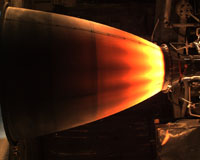 |
Sacramento CA (SPX) May 06, 2010 Aerojet has announced that NASA has successfully completed altitude testing of Aerojet's advanced 5500-lbf Liquid Oxygen (LOX)/Liquid Methane (LCH4) Rocket Engine at NASA's White Sands Test Facility (WSTF). The 5500-lbf LO2/LCH4 engine development effort is funded by the Propulsion and Cryogenics Advanced Development Project (PCAD) under NASA's Exploration Technology Development Program. The first-generation Aerojet LO2/LCH4 engine, operating at WSTF, is shown in Figure 1 at T + 40 seconds when the engine assembly has reached steady state thermal equilibrium. The engine, as tested at WSTF, demonstrated a specific impulse (Isp) of 345.2 seconds, and based upon an Aerojet extrapolation of the data to a flight type configuration, it would be capable of producing a specific impulse (Isp) of 350 seconds. Multiple vehicle study activities have shown that a cryogenic LOX/LCH4 propellant combination provides advantages for long-duration storage in space and the ability to be extended for future missions to Mars. This propellant combination is also being studied as a promising option for other deep-space missions due to potential savings in overall systems mass when compared to conventional propellant (hypergolic) systems. This technology development program's objective is to provide risk reduction data for this new and novel non-toxic propellant combination. The Aerojet 5500-lbf LOX/LCH4 rocket engine program has provided critical data in both sea-level and high-area-ratio nozzle altitude testing. Aerojet completed a sea-level testing campaign of more than 50 hot-fire tests of this advanced engine and more than 769 seconds of total duration in the summer of 2009. The sea-level testing campaign was concluded at Aerojet with successful completion of a continuous ablative chamber test firing for 110 seconds. This test was conducted to obtain the ablative chamber char rates and anchor Aerojet thermal analysis codes for the altitude chamber design. After refurbishment, the sea-level injector was delivered to NASA's WSTF Test Cell 401 for assembly into the altitude test facility. The altitude engine assembly consists of igniter and injector propellant valves, an altitude ablative chamber and a columbium nozzle extension. The Aerojet altitude engine completed the altitude test matrix, which consisted of eight tests at different mixture ratios and durations. Initial hot fire data and performance data reduction analyses have been completed. Mark Klem, program manager of NASA's Propulsion and Cryogenics Advanced Development (PCAD) program said, "This testing has provided us with extremely valuable altitude test data to improve the database and design tools for liquid oxygen/liquid methane engines. The NASA and Aerojet team should be complimented on their hard work to provide these data and design tools that are needed to take us a step closer to designing a flight engine."
Share This Article With Planet Earth
Related Links Aerojet Rocket Science News at Space-Travel.Com
 Aerojet And Florida Turbine Technologies To Develop NASA's New Rocket Engines
Aerojet And Florida Turbine Technologies To Develop NASA's New Rocket EnginesSacramento CA (SPX) May 04, 2010 Aerojet and Florida Turbine Technologies (FTT) have announced that the companies have entered into a strategic partnership to compete for research, development and production on NASA's new hydrocarbon engine and advanced upper stage engine. This expands the very successful teamwork that Aerojet and FTT have underway on the U.S. Air Force Hydrocarbon Boost Technology Demonstrator (HBTD) and ... read more |
|
| The content herein, unless otherwise known to be public domain, are Copyright 1995-2010 - SpaceDaily. AFP and UPI Wire Stories are copyright Agence France-Presse and United Press International. ESA Portal Reports are copyright European Space Agency. All NASA sourced material is public domain. Additional copyrights may apply in whole or part to other bona fide parties. Advertising does not imply endorsement,agreement or approval of any opinions, statements or information provided by SpaceDaily on any Web page published or hosted by SpaceDaily. Privacy Statement |